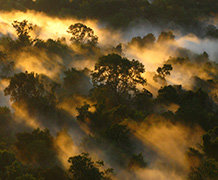
The Nature paper shows how the Amazon’s carbon sink has declined as tree death accelerated. Image courtesy Peter van der Sleen
Amazon’s carbon uptake declines as trees die faster
The most extensive land-based study of the Amazon to date reveals it is losing its capacity to absorb carbon from the atmosphere.
The results of this monumental 30-year survey of the South American rainforest, which involved an international team of almost 100 researchers, are published today in the journal Nature.
Over recent decades the Amazon forest has acted as a vast ‘carbon sink’ – absorbing more carbon from the atmosphere than it releases – helping to put a brake on the rate of climate change. But a new analysis of forest dynamics shows a huge surge in the rate of trees dying across the Amazon.
Lead author Dr Roel Brienen, from the School of Geography at the University of Leeds, said: “Tree mortality rates have increased by more than a third since the mid-1980s, and this is affecting the Amazon’s capacity to store carbon.”
Dr Ted Feldpausch, co-author and researcher in Geography at the University of Exeter, said, “We measured an increase in growth rates, with this increase representing a rise in the capacity of forests to accumulate carbon in trees. However, over time, the growth rate increases that we have observed for Amazonian forests over the last few decades have begun to level off. The results raise many questions about environmental drivers of this change.”
Initially, an increase in carbon dioxide in the atmosphere – a key ingredient for photosynthesis – led to a growth spurt for the Amazon’s trees, the researchers say. But the extra carbon appears to have had unexpected consequences.
Study co-author Professor Oliver Phillips, from the University of Leeds said: “With time, the growth stimulation feeds through the system, causing trees to live faster, and so die younger.”
Recent droughts and unusually high temperatures in the Amazon may also be playing a role. Although the study finds that tree mortality increases began well before an intense drought in 2005, it also shows that drought has killed millions of additional trees.
The Nature paper shows how the Amazon’s carbon sink has declined as tree death accelerated. From a peak of two billion tonnes of carbon dioxide each year in the 1990s, the net uptake by the forest has weakened by a half, and is now, for the first time, being overtaken by fossil fuel emissions in Latin America.
Dr Brienen said: “Regardless of the causes behind the increase in tree mortality, this study shows that predictions of a continuing increase of carbon storage in tropical forests may be too optimistic.
“Climate change models that include vegetation responses assume that as long as carbon dioxide levels keep increasing, then the Amazon will continue to accumulate carbon. Our study shows that this may not be the case and that tree mortality processes are critical in this system.”
The study involved almost 100 scientists, many working for decades across eight countries in South America. The work was coordinated by RAINFOR, a unique research network dedicated to monitoring the Amazonian forests.
To calculate changes in carbon storage they examined 321 forest plots across the Amazon’s six million square kilometres, identified and measured 200,000 trees, and recorded tree deaths as well as growth and new trees since the 1980s.
“All across the world even intact forests are changing”, added Professor Phillips. “Forests are doing us a huge favour, but we can’t rely on them to solve the carbon problem. Instead, deeper cuts in emissions will be required to stabilise our climate.”
Date: 19 March 2015
